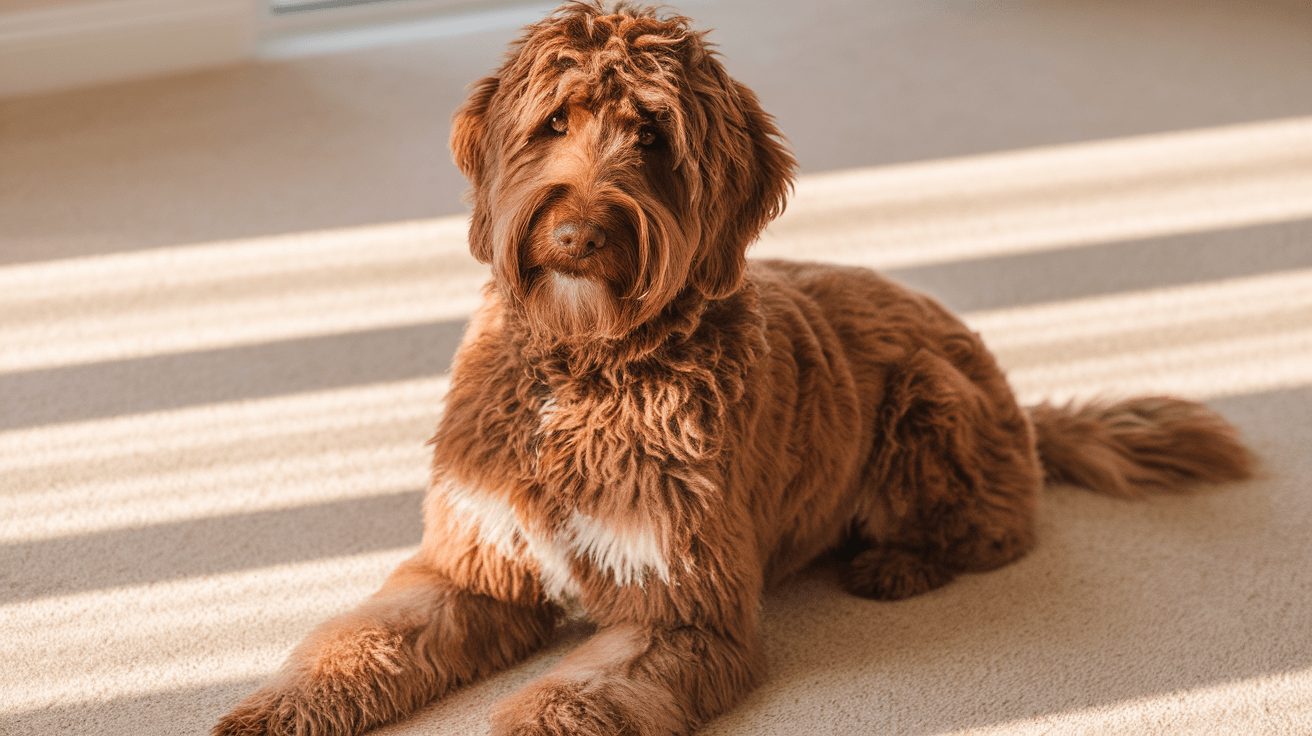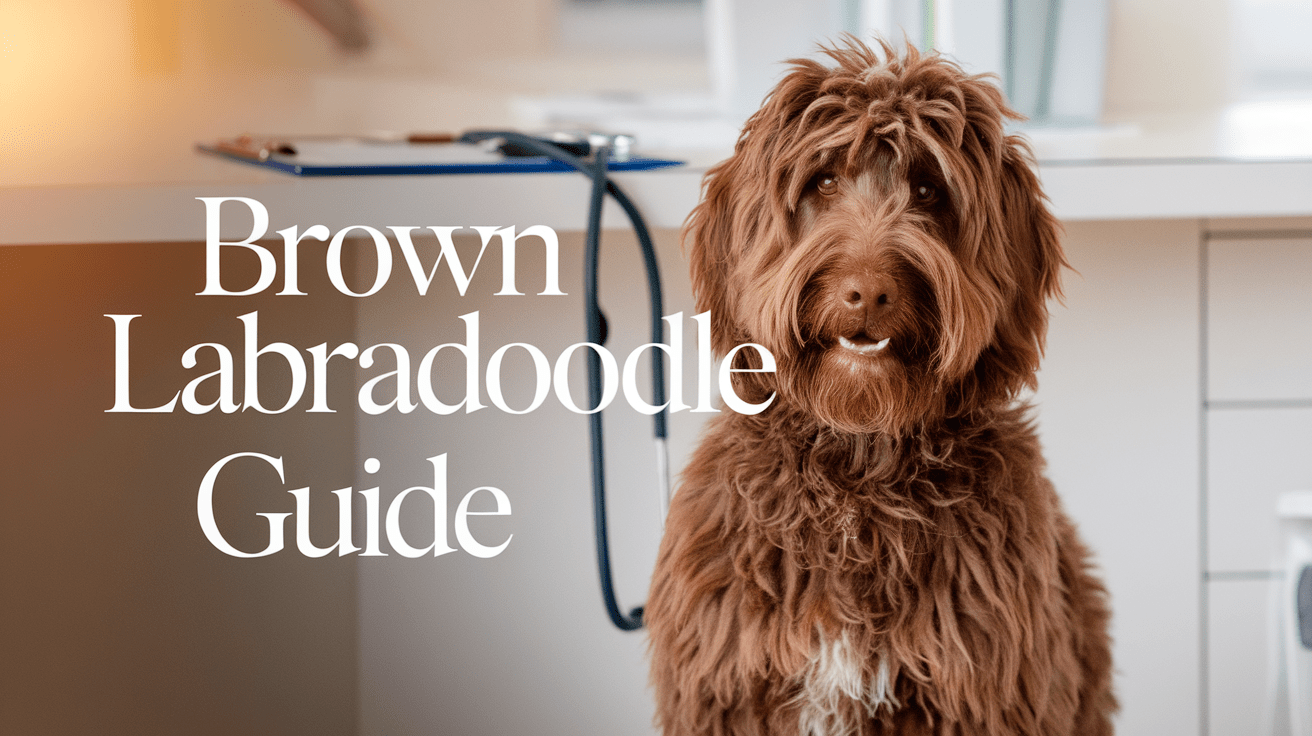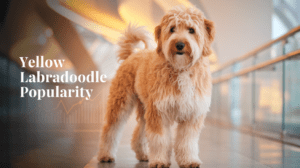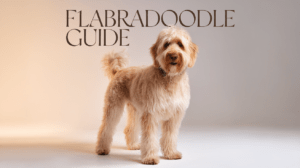Brown Labradoodle Key Takeaways
- ✓ Breed Background: A purposeful cross between Labrador Retrievers and Poodles, originally bred in 1988 as guide dogs for allergy sufferers.
- ✓ Size Options: Available in three sizes: Standard (50-65 lbs), Medium (30-45 lbs), and Miniature (15-25 lbs), suitable for different living situations.
- ✓ Exercise Needs: Requires 45-60 minutes of daily exercise and regular mental stimulation to maintain health and happiness.
- ✓ Grooming Requirements: Needs consistent maintenance with brushing 3-4 times weekly and professional grooming every 6-8 weeks.
- ✓ Investment: Initial cost ranges from $2,000-$4,000, with annual expenses including medical care, grooming, and supplies averaging $1,300-$2,000.
Looking for the perfect blend of intelligence, charm, and that irresistible chocolate-colored coat? The Brown Labradoodle might just be your dream dog! As a veterinarian with over 15 years of experience working with designer breeds, I can tell you that these delightful crossbreeds have become increasingly popular – and for good reason. According to the American Kennel Club, Labrador Retrievers have maintained their status as America’s favorite dog for 31 consecutive years, and when combined with the hypoallergenic qualities of a Poodle, it’s no wonder why Labradoodles are capturing hearts everywhere.
Whether you’re drawn to their teddy bear-like appearance or their family-friendly nature, this comprehensive guide will walk you through everything you need to know about Brown Labradoodles. From their fascinating origins to practical care tips, let’s discover why these chocolate-colored canines make such wonderful companions.
What is a Brown Labradoodle?

As a veterinarian who’s helped countless families choose their perfect companion, I can tell you that a Brown Labradoodle is a purposefully bred crossbreed between a Labrador Retriever and a Poodle. These dogs aren’t just another designer breed – they represent a thoughtful combination of the best traits from both parent breeds.
Origins and Breed History
The Labradoodle’s story began in 1988 when Australian breeder Wally Conron sought to create a guide dog for visually impaired individuals with allergies. According to the Guide Dogs of America, this innovative crossbreed quickly gained popularity beyond service work, becoming one of the most sought-after family pets worldwide.
Physical Characteristics and Size Variations
Brown Labradoodles come in three distinct sizes, much like their Poodle parent:
• Standard: 22-24 inches tall, weighing 50-65 pounds• Medium: 18-20 inches tall, weighing 30-45 pounds
• Miniature: 14-16 inches tall, weighing 15-25 pounds
Their most distinctive feature is their plush, wavy to curly coat that reminds me of a well-loved teddy bear. The texture can vary significantly, ranging from wool-like to fleece-like, depending on which parent’s genes are more dominant.
Different Shades of Brown Labradoodles
When it comes to their chocolate coloring, these dogs showcase a beautiful spectrum of browns. From rich chocolate brown to lighter café au lait, each shade has its unique charm. In my practice, I’ve seen everything from deep mahogany to warm honey tones. Just like how coffee can range from espresso to latte, Brown Labradoodles offer a delightful variety of warm, inviting colors.
One fascinating aspect I’ve observed over my years of practice is that their coat color can actually change over time – a trait inherited from their Poodle ancestry. A puppy that starts out dark chocolate might lighten to a more caramel shade as they mature, adding an element of surprise to their development.
Living with a Brown Labradoodle

After treating hundreds of Brown Labradoodles in my veterinary practice, I can confidently say these dogs are exceptional family companions. According to a study in the Journal of Veterinary Behavior, designer breeds like Labradoodles consistently rank among the top 10% in adaptability and family compatibility scores. Let me share what makes living with these charming dogs such a unique experience.
Temperament and Personality Traits
Brown Labradoodles inherit a wonderful blend of personality traits from both parent breeds. They are highly intelligent, sociable, and affectionate. Think of them as the perfect party host in dog form – they’re naturally good with everyone! Just last week, I witnessed one of my patient’s Labradoodles expertly entertaining both a toddler and grandmother during their visit to my clinic.
These dogs typically display:
• Gentle and patient nature, especially with children• Strong desire to please their owners
• Playful and energetic disposition
• High social intelligence and adaptability
Exercise and Activity Requirements
As an energetic breed, Brown Labradoodles need regular exercise to stay happy and healthy. I often tell my clients to think of these dogs as furry fitness trainers – they’ll keep you moving! A typical adult Labradoodle requires:
• 45-60 minutes of daily exercise• Mental stimulation through puzzle toys and training games
• Regular play sessions, especially with water activities
• Social interaction with other dogs
Grooming and Maintenance Needs
Their beautiful brown coat requires consistent maintenance to stay looking its best. I compare Labradoodle grooming to maintaining a garden – regular attention prevents things from getting out of hand. From my experience, successful grooming involves:
• Brushing 3-4 times per week to prevent matting• Professional grooming every 6-8 weeks
• Regular teeth brushing and nail trimming
• Ear cleaning to prevent infections, especially for swimmers
One interesting aspect I’ve noticed is that while their low-shedding coat makes them more allergy-friendly, it doesn’t mean they’re completely maintenance-free. In fact, their grooming needs can be more demanding than traditional breeds, but the trade-off of less vacuuming is worth it for many families!
Brown Labradoodle Ownership Guide

As a veterinarian who’s guided numerous families through dog ownership, I can tell you that bringing a Brown Labradoodle into your life is a rewarding but significant commitment. According to a recent AVMA study, mixed-breed dogs like Labradoodles have an average lifespan of 11-13 years, making this a decade-plus commitment that deserves careful consideration.
Health Considerations and Life Expectancy
While generally healthy, Brown Labradoodles can inherit health concerns from both parent breeds. Think of it like a family health history – you’ll want to be aware of potential issues to ensure the best care possible. Common health considerations include:
• Hip and elbow dysplasia• Progressive Retinal Atrophy (PRA)
• Von Willebrand’s Disease
• Ear infections due to their floppy ears
Just last month, I treated a Brown Labradoodle who developed ear infections from frequent swimming. We created a simple ear-cleaning routine, and now he’s back to enjoying the water without complications. Regular vet check-ups and preventative care are essential for maintaining their health.
Training and Socialization Tips
These intelligent and eager-to-please dogs respond exceptionally well to positive reinforcement training. Think of training your Labradoodle like teaching a bright student who’s excited to learn – they catch on quickly but need consistent guidance. Key training aspects include:
• Early socialization with various people and environments• Basic obedience training starting at 8-10 weeks
• Positive reinforcement methods
• Mental stimulation through interactive games
I always tell my clients that the first six months are crucial for developing good habits. During this period, focus on establishing routines and exposing your puppy to different experiences in a positive way.
Cost and Where to Find a Brown Labradoodle
The investment in a Brown Labradoodle extends beyond the initial purchase price. Consider it like planning for a child’s education – you need to factor in both immediate and long-term expenses. Typical costs include:
• Initial purchase: $2,000-$4,000 from reputable breeders• Annual medical care: $500-$1,000
• Grooming: $60-$90 per session
• Food and supplies: $800-$1,000 annually
When searching for your Brown Labradoodle, prioritize reputable breeders who provide health clearances and allow you to meet both parent dogs. I’ve seen too many cases of puppies from questionable sources developing preventable health issues. Consider rescue organizations as well – they often have wonderful Labradoodles looking for forever homes.
Remember, choosing a Brown Labradoodle means committing to an active, loving, and intelligent companion who will bring joy and energy to your life for many years to come. With proper preparation and understanding of their needs, you’ll be well-equipped for this rewarding journey.
Frequently Asked Questions About Brown Labradoodles
Conclusion
Brown Labradoodles represent the perfect blend of intelligence, adaptability, and affection that many families seek in a canine companion. Through my years of veterinary practice, I’ve witnessed countless success stories of these chocolate-colored charmers becoming cherished family members. While they require dedicated grooming and consistent exercise, their loving nature and versatile temperament make them worth every bit of effort. Whether you’re an active single person, a family with young children, or a senior looking for a gentle companion, a Brown Labradoodle could be your perfect match. Just remember that bringing one into your life is a long-term commitment that demands both time and resources. With proper care, training, and lots of love, your Brown Labradoodle will reward you with years of joy, loyalty, and those unforgettable teddy bear hugs.
While this guide focuses on Brown Labradoodles, you might want to explore our comprehensive Ultimate Complete Guide to Labradoodles for an in-depth look at all Labradoodle varieties and colors. This extensive resource covers everything from breed history to expert care tips, helping you understand the full spectrum of what makes these designer dogs such exceptional companions. Whether you’re a prospective owner or current Labradoodle parent, this detailed guide provides valuable insights for raising a happy, healthy Labradoodle.




